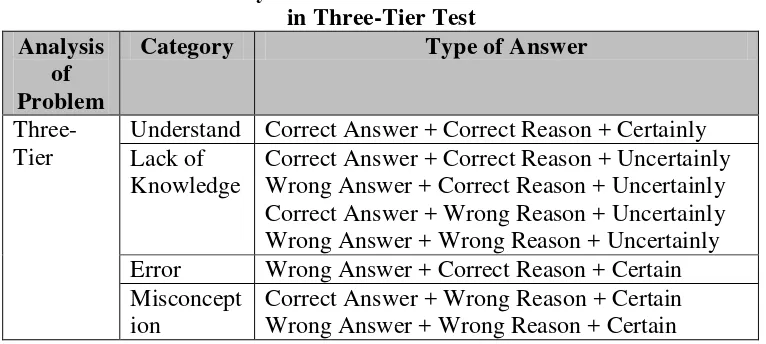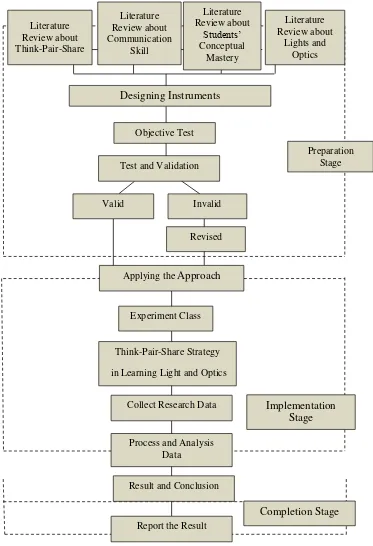Intan Mar Atus Sholihah, 2016
Pengaruh Strategi Think-Pair-Share Terhadap Kemampuan Berkomunikasi dan Pemahaman Konsep Peserta Didik dalam Pembelajaran Cahaya Dan Optik
Universitas Pendidikan Indonesia | repository.upi.edu | perpustakaan.upi.edu CHAPTER III
METHODOLOGY
A. Research Method and Research Design
The method which was used is poor or weak experiment method. According to Fraenkel, Wallen, & Hyun (2011), this design is weak and do not have built-in control for threats to internal validity. In addition to the independent variable, there are number of other plausible explanations for any outcomes that occur.
The design used in this research is One-Group Pretest-Posttest Design. Based on Fraenkel, Wallen, & Hyun (2011), in the one-group pretest-posttest design, a single group is measured or observed not only after being exposed to treatment of some sort, but also before. Table 3.1 shows how the research is designed.
Table 3.1 One-Group Pretest-Posttest Design
O X O
Pretest Treatment Posttest
(Fraenkel, Wallen, & Hyun 2011)
In case of the research done, the diagram of the research design is shown in Table 3.2.
Table 3.2 One-Group Pretest-Posttest Design
O X O
Pretest: (25 items related to
Lights and Optics concept were given) (Dependent Variable)
Treatment (Four treatments done using Think-Pair-Share
strategy)
Posttest: (25 items related to
Lights and Optics concept were given) (Dependent Variable)
Intan Mar Atus Sholihah, 2016
Pengaruh Strategi Think-Pair-Share Terhadap Kemampuan Berkomunikasi dan Pemahaman Konsep Peserta Didik dalam Pembelajaran Cahaya Dan Optik
Universitas Pendidikan Indonesia | repository.upi.edu | perpustakaan.upi.edu
since it monitor the effect of the teaching method used upon a group of students in one class since there is no control group for comparison.
B. Participants, Population, and Sample
The location of this research is at one of Junior High School in Bandung. The population of this research is almost all of the students in one of the class in 8th grade. The sampling technique used was purposive sampling. Based on Fraenkel & Wallen (2007), purposive sampling is the sampling in which researchers do not simply study whoever is available but rather uses their judgment to select a sample that they believe, based on prior information, will provide the data they need. There are 25 students from one class that assigned as samples in this research.
C. Research Instruments
The instruments used in this research are: 1. Visual Communication Rubric
The rubric used is the visual communication rubric which is adapted from the mind map rubric created by Language and Learning Online in Jones, et. al. (2012). Even though students are asked to create a poster, because of the limitation of time in teaching learning process and the limitation of tools and materials to support their work making a poster, the rubric for scoring poster is not used, but the rubric used is for the visual communication rubric which is created by the researcher. The rubric used to evaluate three aspects or three components of the visual display (simple poster) the students created which are content, color, and image. The criteria for every score given are shown in the Table 3.3.
Table 3.3 Visual Communication Rubric
Aspects Content Color Image
Intan Mar Atus Sholihah, 2016
Pengaruh Strategi Think-Pair-Share Terhadap Kemampuan Berkomunikasi dan Pemahaman Konsep Peserta Didik dalam Pembelajaran Cahaya Dan Optik
Universitas Pendidikan Indonesia | repository.upi.edu | perpustakaan.upi.edu
Aspects Content Color Image
material.
Multiple choice questions in this research instruments used to measure students’ conceptual mastery including remembering (C1), understanding (C2), and applying (C3) based on A Revision of Bloom’s Taxonomy. The multiple choice questions include 25 questions. The questions given as pretest and posttest after the students get treatment with test-measuring technique.
Intan Mar Atus Sholihah, 2016
Pengaruh Strategi Think-Pair-Share Terhadap Kemampuan Berkomunikasi dan Pemahaman Konsep Peserta Didik dalam Pembelajaran Cahaya Dan Optik
Universitas Pendidikan Indonesia | repository.upi.edu | perpustakaan.upi.edu
Table 3.4 Analysis of Students’ Answers Combination in Three-Tier Test
Analysis of Problem
Category Type of Answer
Three-Tier
Understand Correct Answer + Correct Reason + Certainly Lack of
Knowledge
Correct Answer + Correct Reason + Uncertainly Wrong Answer + Correct Reason + Uncertainly Correct Answer + Wrong Reason + Uncertainly Wrong Answer + Wrong Reason + Uncertainly Error Wrong Answer + Correct Reason + Certain Misconcept
ion
Correct Answer + Wrong Reason + Certain Wrong Answer + Wrong Reason + Certain
3. Observation Sheet
The approach of teaching used was cooperative learning using Think-Pair-Share strategy. The teaching-learning activities have had to follow the syntax of Think-Pair-Share which is developed in certain lesson plans supported by worksheets. Observation sheet was used by the observer to measure the teaching learning activities done by the researcher. The observation sheet gave the information about the percentage of activities done based on the lesson plan.
D. Instrument Validation Results
Intan Mar Atus Sholihah, 2016
Pengaruh Strategi Think-Pair-Share Terhadap Kemampuan Berkomunikasi dan Pemahaman Konsep Peserta Didik dalam Pembelajaran Cahaya Dan Optik
Universitas Pendidikan Indonesia | repository.upi.edu | perpustakaan.upi.edu
from expert judgments. The reliability of the test item is 0.51, which included as fair.
The instruments of multiple choice questions consist of four sub-concepts of lights and optics. The measurement that is used as consideration of the usage of instrument from ANATEST 4.0 is the reliability. The validation of instruments is more considered from the expert judgments. Several revisions are done based on the recommendations from judgments but the content of the questions does not really change.
E. Procedure
The steps are including the following activities below:
1) Literature review conducted to analyze the information about Think-Pair-Share, communication skill, students’ communication skill, and Lights and Optics.
2) As the result of literature review, research problem is identified and elaborated into several research question arranged. In order to answering research questions, instruments will be arranged as tools to obtain the data. Arrangement of instruments including objective test, rubrics to measure students’ communication skill, and observation sheet Instructional tools will be used are lesson plan and worksheet that arranged to help the implementation of Think-Pair-Share strategy. 3) Judgment of instruments will be conducted by experts.
4) Trial test of objective test instrument will be conducted to identify the quality of instrument.
5) The result of multiple choice questions test trial will be analyzed. 6) Revision of instruments will be done based on judgment result and test
item analysis.
b. Implementation Stage
Intan Mar Atus Sholihah, 2016
Pengaruh Strategi Think-Pair-Share Terhadap Kemampuan Berkomunikasi dan Pemahaman Konsep Peserta Didik dalam Pembelajaran Cahaya Dan Optik
Universitas Pendidikan Indonesia | repository.upi.edu | perpustakaan.upi.edu
1) Pre-test will be conducted to identify students’ preliminary skills. 2) Treatment will be conducted in the last meeting of the topic learned to
review about Lights and Optics. 3) Post-test will be conducted. c. Completion Stage
Completion stage consists of four stages, which are: 1) All of data will be obtained then calculated. 2) The result of data calculation will be analyzed.
Intan Mar Atus Sholihah, 2016
Pengaruh Strategi Think-Pair-Share Terhadap Kemampuan Berkomunikasi dan Pemahaman Konsep Peserta Didik dalam Pembelajaran Cahaya Dan Optik
Universitas Pendidikan Indonesia | repository.upi.edu | perpustakaan.upi.edu Figure 3.1 Flowchart of Research Procedure
Literature Review about Think-Pair-Share
Designing Instruments
Objective Test
Test and Validation
Valid Invalid
Revised
Experiment Class
Think-Pair-Share Strategy
in Learning Light and Optics
Collect Research Data
Result and Conclusion
Report the Result
Implementation Stage
Completion Stage Applying the Approach
Process and Analysis Data
Preparation Stage Literature
Review about Communication
Skill
Literature Review about
Students’ Conceptual
Mastery
Literature Review about
Intan Mar Atus Sholihah, 2016
Pengaruh Strategi Think-Pair-Share Terhadap Kemampuan Berkomunikasi dan Pemahaman Konsep Peserta Didik dalam Pembelajaran Cahaya Dan Optik
Universitas Pendidikan Indonesia | repository.upi.edu | perpustakaan.upi.edu F. Data Analysis
1. Hypothesis Test
The hypothesis in this research tested using SPSS for Windows Version 23.0 program. Before determining which kind of hypothesis test that will be used, the test of normality done. If the data is normally distributed, the test of hypothesis which is used is parametric test. If not, the test which is used is non-parametric test.
The hypothesis test of differentiation is used to see whether pretest and posttest score have difference result or not. The hypothesis which is tested is shown as follow:
H0 : There is no difference in students’ conceptual mastery on learning lights and optics after using Think-Pair-Share strategy.
H1 : There is difference in students’ conceptual mastery on learning lights and optics using Think-Pair-Share strategy.
2. Normalized Gain Test
The enhancement of students’ conceptual mastery in pretest and posttest results was calculated using normalized gain equation. Based on Hake (1999), the pretest and posttest could be computed using the equation below:
The data then interpreted into a normalized gain criteria as shown below:
Table 3.5 Criteria of Normalized Gain
<g> Criteria
<g> 0,7 High
0,3 <g> 0,7 Fair
<g> 3 Low
Intan Mar Atus Sholihah, 2016
Pengaruh Strategi Think-Pair-Share Terhadap Kemampuan Berkomunikasi dan Pemahaman Konsep Peserta Didik dalam Pembelajaran Cahaya Dan Optik
Universitas Pendidikan Indonesia | repository.upi.edu | perpustakaan.upi.edu
The data that is used to measure students’ conceptual mastery is the score which measure number of students’ correct answers in one tier test (without giving reason and certainty) in pretest and posttest. However, even though the data used to measure score of students ‘conceptual mastery is one tier test; the test given was three tier test. Three tier test’ data result then used to analyze the number of students who understand in every problem given in pretest and posttest, and also the number of students who get misconception in every problem given in pretest and posttest. Analysis of the data also done by considering cognitive level tested, and based on each sub-concept learned because each sub-concept was taught and learned in different meetings.
3. Analysis of Students’ Misconception and Understanding
This analysis was used three tier test as the instrument. Students’ answer of three tier test in each question was collected and then interpreted based on the rules from Kaltakci & Didis (2007). The number of students which interpreted as students who get misconception and students who understand in pretest and posttest were counted and then compared.
4. Analysis of Students Communication Skill
Students’ poster was scored based on the rubrics. There are three aspects that are used to measure the score of students. Each aspect has three scales. Scale 1 is categorized as need improvement category, scale 2 is categorized as fair category, while scale 3 is categorized as good.
Each poster are scored, and then the number of students who scored good, fair, and need improvement in every aspects were counted and then converted in to percentage.
Intan Mar Atus Sholihah, 2016
Pengaruh Strategi Think-Pair-Share Terhadap Kemampuan Berkomunikasi dan Pemahaman Konsep Peserta Didik dalam Pembelajaran Cahaya Dan Optik
Universitas Pendidikan Indonesia | repository.upi.edu | perpustakaan.upi.edu
In order to avoid misconception about this research, some operational definitions are explained in this research. The terminologies are as follow:
a. Think-Pair-Share as a learning model which have three stages in which teacher gives time for students to think in personal about a problem given by the teacher, and then teacher gives the students time to discuss their thoughts with their pair, after that they have to share their result of discussion with a larger group or the whole class. The learning process is conducted based on lesson plan, and is checked by observation sheet.
b. Students’ communication in this research is the competence of students which covers students’ interaction, students’ understanding about the terminologies, and students’ ability to represent their ideas in a simple poster which is measured using visual communication rubric.



